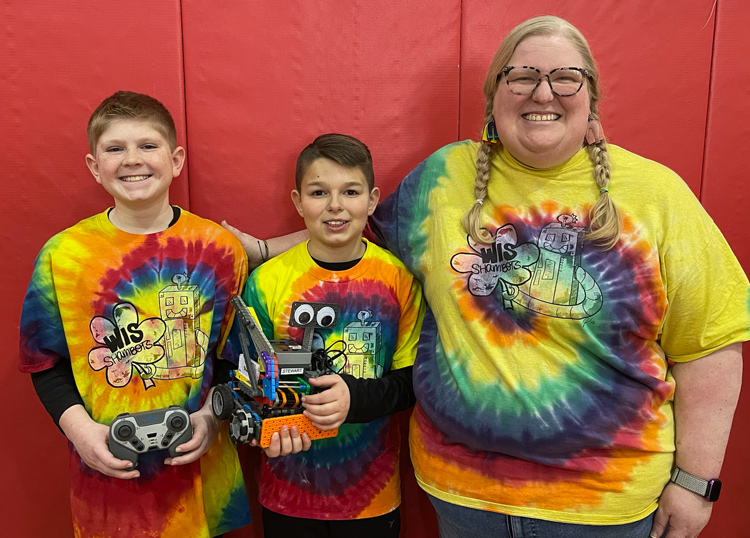Westfield Washington Schools recently received a $50,000 grant from the Indiana Department of Education that will go to the robotics programs at the high school, middle school, and intermediate schools, each of which has an existing robotics team.
The Reporter spoke to instructors at each of the three schools about the programs, the students, and how this money will help.
“We’re really lucky that all of the elementary schools have a team,” Westfield Intermediate School Robotics Instructor Holly Foltz said. “When they get here to the intermediate school, we are just inundated. We usually get 200 kids apply for the team.”

The Westfield Intermediate Schools Robotics Team. (Photo provided)
Foltz told The Reporter having that many students apply is a challenge, but she said she feels very lucky to have so many elementary students and teams involved in Westfield because that allows for a strong program at the intermediate, middle, and high school levels.
“These kids are brilliant,” Foltz said. “This is the first year we’re really spreading our wings. VEX Robotics has suggested builds you can use. We use VEX competitions. But the past couple years we’ve really struggled with their suggested robot for competition. So I took some classes this summer to learn more about the design process and the kids have been designing their own robots this year. And it is just wild to see.”

Photo provided
Foltz said when she was in school the height of computer technology in schools involved a lab in which she recalls playing The Oregon Trail.
“It’s fascinating to me to watch these kids completely design these robots from scratch and then build them, test them, take them to competition at 10 and 11 years old,” Foltz said.
Of the $50,000 in grant money, over $10,000 will go to the six teams in the intermediate school, allowing for the purchase of updated “brains” (processors and motherboards) for student robots and allowing the school to more easily pay for competition fees.

Photo provided
Lori Miller told The Reporter the middle school has a small program with 22 students and one competition team.
“With this type of a grant, it’s going to be so helpful over time if we can continue it year after year to build up our program so we are on par with the high school and the intermediate school,” Miller said.
The intermediate school, by comparison, takes six team to competitions.

Photo provided
High School Instructor Brian Ulkloss said he is proud of his students and their record of qualifying for state competition every year the program has existed.
“We have a variety of different students with different interests and backgrounds coming together to build our robot and be on our team,” Ulkloss said. “We’ve got opportunities that involve getting to do the hands-on building part. We’ve got kids that are really involved with the actual construction and putting things together. But not every kid is interested in doing that. We try and find a role for every kid to find their space on the team.”
Some of his students gravitate toward computer-aided design of new parts that cannot be purchased off the shelf. Some focus entirely on programming, and some work on the marketing side, focusing in social media, promotional photos, and community outreach.

The 2022-2023 Westfield High School Robotics Team. (Photo provided)
At the high school level, there are also mentoring opportunities for students.
“Our kids are mentoring the younger kids to sort of show them what the, the robotics is all about and how the engineering process works and that sort of thing,” Ulkloss said.
In the middle school, Miller said she has students who are not at all interested in the competitions.
“Several are here for the camaraderie,” Miller said. “They’re here to help with the building. I will say I was really pleasantly surprised to see the number of girls that came on our first day for our program and they’re still here. Girls and coding typically is not something that you see in large amounts. I give credit to intermediate school for that, for sending them over and getting them all excited to continue.”
Foltz said the intermediate school tried to have a roughly equal number of boys and girls in their 200-student program because she knows it becomes more of a male program at higher levels.
“I think it helps to have some female coaches too,” Foltz said. “We really try and encourage the girls to stick with it.”
While the high school program has students who focus on one aspect or another, at the intermediate level Foltz said they have students try a little of everything to help them find out where their interests and skills are.
According to Ulkloss, the high school team has 25 members, only one of which is a female student.
“We’ve been discussing ways to hopefully try and encourage more young ladies to get involved,” Ulkloss said. “We’ve been trying to recruit through the women in STEM club. Right now we have only one girl out of our 25 members that are on a team here. But we’re hoping to try and expand that.”
Ulkloss said he is very proud of how many students from Westfield robotics have continued that interest after high school. Several have gone to Purdue and other colleges where they continue to study robotic and mentor younger teams.
“Really what the goal is, is to get the kids inspired and get them reaching out and mentoring others,” Ulkloss said. “I think we’ve done very well in that regard.”


How do I get my daughters involved in the robotics program?